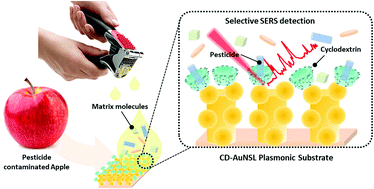A cyclodextrin-decorated plasmonic gold nanosatellite substrate for selective detection of bipyridylium pesticides†
Abstract
A cyclodextrin-decorated gold nanosatellite (AuNSL) substrate was developed as a surface-enhanced Raman scattering sensor for the selective sensing of bipyridylium pesticides such as paraquat (PQ), diquat (DQ), and difenzoquat (DIF). The AuNSL structure was fabricated via vacuum deposition of gold nanoparticles (AuNPs) on a gold nanopillar substrate, and a large density of hot-spots was formed for Raman signal enhancement. Thiolated β-cyclodextrin (SH-CD) was surface-modified on the AuNSL as a chemical receptor. The detection limit of PQ, DQ, and DIF on the SH-CD-coated AuNSL (CD-AuNSL) was 0.05 ppm for each, and showed linear correlation in a concentration range of 10 ppm–0.05 ppm. Then, selective bipyridylium pesticide detection was performed by comparing the Raman intensity of each pesticide with and without the washing step. After the washing step, 90% of the PQ, DQ, and DIF Raman signals were maintained on the CD-AuNSL substrate with a uniform selectivity in a mapping area of 200 μm × 200 μm. Furthermore, selective pesticide detection was performed using a ground-apple solution without pretreatment. Raman signals were clearly observed after the washing step and they showed a limit of detection down to a concentration of 0.05 ppm for each pesticide. Principal component analysis (PCA) of the binary and ternary mixtures of PQ, DQ, and DIF showed that each component could be easily identified via the typical Raman fingerprint analysis. The developed CD-AuNSL is expected to be applied for various chemical sensors, especially for pyridine-containing toxic substances in the environment and metabolite biomarkers in biofluids.



 Please wait while we load your content...
Please wait while we load your content...